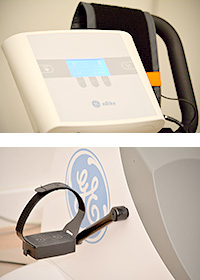Ergometry

When is an ergometry performed?
In conjunction with cardiac ultrasound, ergometry is one of the most important investigations in cardiology. Its purposes include a diagnostic investigation of physical performance, clarification of hypertensive diseases, and checking an ongoing treatment for hypertension. The ergometry permits the physician to detect or rule out calcifications of the coronary vessels. It also aids in the diagnosis of arrhythmia and in determining the optimal training pulse rate.
How is an ergometry performed?
An ergometry or a stress ECG is usually performed on a bicycle ergometer. For this purpose the patient is subjected to a specific pattern of physical stress under continuous monitoring with a 12-lead ECG and blood pressure monitoring. The values are recorded and displayed graphically, and can be analyzed afterwards. Changes in the ECG provide the cardiologist with crucial information about the condition of the coronary vessels, the ongoing stabilization of blood pressure, the fitness level of the patient, and much more.
You are advised to wear comfortable casual clothes for the ergometry, but this is not a must. You should take a light breakfast and not be in a fasting state when you come for the ergometry.





